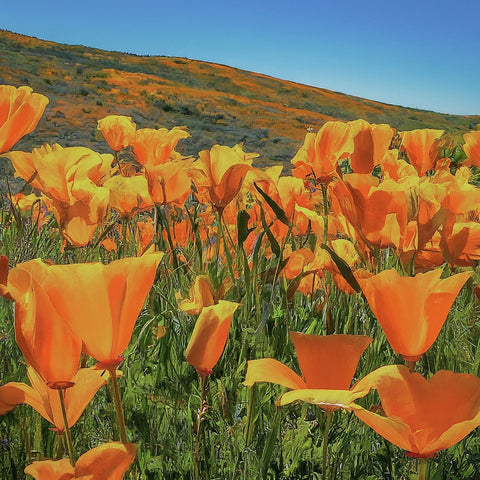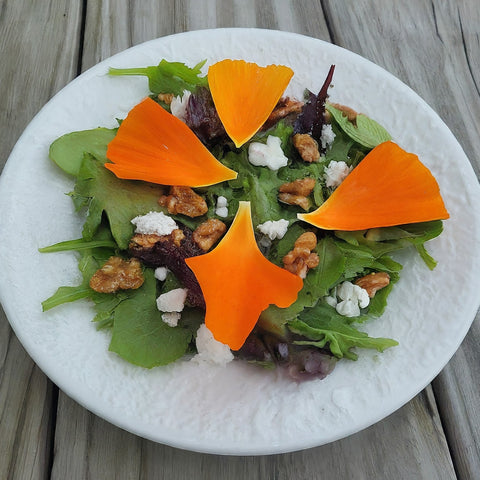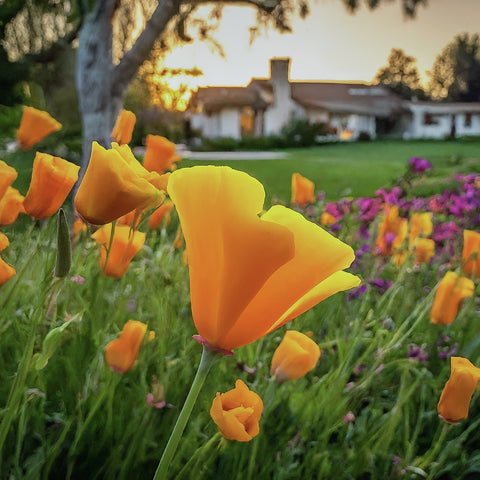
Is California Poppy Edible?
Share
California poppies, with their vibrant orange blooms, are a symbol of the Golden State's sunshine and beauty. But beyond aesthetics, can these cheerful flowers be enjoyed on our plates as well? This article delves into the edibility of California poppies, exploring their culinary uses, safety considerations, and potential health benefits.

Demystifying the California Poppy
Unveiling the Golden Gem: A Closer Look at the California Poppy
California's vibrant landscapes wouldn't be the same without the cheerful blaze of orange that carpets its hillsides. But this iconic flower, the California poppy (Eschscholzia californica), is more than just a pretty face. Get ready to unearth the secrets behind this sunshine symbol!
Where Does the California Poppy Shine?
Unlike its name might suggest, the California poppy isn't confined solely to the Golden State. It thrives throughout western North America, painting fields with color from southern Washington and Oregon all the way down to Baja California and Mexico. This adaptable wildflower isn't picky about its address either, flourishing in a range of habitats – open grasslands, valleys bathed in sunshine, and even roadsides.
A Field Guide to the California Poppy:
Imagine a plant that embodies the essence of California sunshine. The California poppy nails that description perfectly. Picture delicate, blue-green feathery leaves that dance in the breeze. Then, atop slender stems, stand the showstoppers: brilliant orange flowers with four silky petals, each boasting a crinkled texture reminiscent of fine crepe paper. But don't be fooled by their delicate appearance – these blooms are surprisingly tough, able to withstand periods of drought thanks to their deep taproot.
Poppy Pals or Distant Relatives? The California Poppy's Family Tree
The California poppy belongs to the Papaveraceae family, a group known for its showy flowers. However, within this diverse bunch, the California poppy occupies a distinct branch. Unlike its infamous cousin, the opium poppy (Papaver somniferum), the California poppy doesn't contain any narcotic properties. So, you can rest assured that admiring these golden beauties won't send you into a blissful slumber (though their calming properties might be a different story – we'll explore that later!).
In fact, the California poppy's closest relatives are actually ornamental flowers like the Iceland poppy and the prickly poppy. These shared cousins hint at the ornamental potential of the California poppy, not just for beautifying fields but potentially for adding a touch of sunshine to your garden as well.

Edibility of California Poppies: A Culinary Adventure Awaits!
Get ready to transform your meals from ordinary to extraordinary with the vibrant California poppy! Believe it or not, these sunshine-colored beauties offer a surprising culinary adventure. But before you head out with basket in hand, let's explore exactly which parts of the plant are edible and how to incorporate them into your dishes.
Flowers Take Center Stage: The star of the show is undoubtedly the poppy's stunning bloom. Both the petals and stamen are edible, offering a delightful peppery kick with a hint of citrus. Imagine tossing these fiery orange petals into a fresh summer salad for a burst of color and unexpected flavor. Or, elevate your next cheese board with vibrant poppy flowers nestled alongside creamy cheeses and crisp crackers.
Don't Forget the Young Leaves: While the flowers steal the spotlight, the young leaves of the California poppy shouldn't be overlooked. Tender and slightly bitter, they add a unique dimension to your culinary creations. Think of them as a zesty green for your next stir-fry or a surprising addition to a flavorful pesto.
Seeds: Tiny Treasures with Big Potential: Let's not forget the tiny but mighty seeds! Once the flowers have faded, harvest the seed pods and discover a treasure trove of culinary possibilities. Grind them into a coarse powder to add a nutty bite to breads and cakes, or sprinkle them whole over yogurt parfaits for a delightful textural contrast.
California poppies aren't just beautiful – they're a delicious waiting to be explored! But remember, responsible foraging is key. We'll delve into safety considerations and harvesting tips in the next section to ensure a safe and sustainable culinary adventure with these edible sunshine nuggets.
Edibility of California Poppies: From Plate to Teacup
California poppies aren't just for admiring – they can be a delightful addition to your culinary adventures!
Transform Your Salads: Imagine tossing vibrant orange poppy petals into your next salad for a burst of color and a peppery, citrusy twist. The young leaves, with their slightly bitter taste, can add a unique dimension to your leafy greens.
Beyond Salads: The possibilities extend far beyond the salad bowl. Utilize the delicate beauty of poppy petals as edible garnishes for cakes, soups, or even cocktails. For a touch of floral elegance, infuse vinegar or oil with dried poppies, adding a subtle floral note to your dishes.
A Global Culinary Tradition: California poppies aren't the only edible blooms! Many cultures have a rich history of incorporating flowers into their cuisine. In Mexico, squash blossoms are dipped in batter and fried, while Japanese cuisine utilizes chrysanthemum petals in tempura. California poppies offer a chance to explore this culinary tradition right in your backyard.
Edibility of California Poppies: A Delicious Journey with Caution
While California poppies might beckon you to sprinkle sunshine onto your next salad, hold on a sec! Before diving headfirst into a floral feast, let's ensure a safe and delicious journey.
Know Your Poppy: California poppies may have sunny smiles, but some not-so-friendly look-alikes lurk in the wild. Misidentification can lead to a real downer, so proper identification is crucial. Familiarize yourself with the California poppy's unique characteristics - its four delicate orange petals, fern-like blue-green leaves, and single flower atop each stem. When in doubt, consult a reliable wildflower identification guide or a local expert.
Listen to Your Body: Even with the correct poppy in hand, allergic reactions are a possibility. Start with a small amount and monitor your body's response. If you experience any discomfort like itching, swelling, or nausea, stop consuming them immediately and seek medical advice.
Extra Caution for Certain Groups: Pregnant and breastfeeding women should exercise extra caution when considering any new plant-based additions to their diet. The potential effects on unborn babies and nursing infants haven't been extensively studied for California poppies. Always consult with your healthcare provider before indulging in these floral delights.
Respect the Poppy Patch: California poppies are a beautiful part of the natural landscape. To ensure their continued vibrancy, practice responsible harvesting. Only pick from healthy, abundant populations, leaving plenty of flowers for future generations to enjoy. Harvest the young flower petals and leaves before they mature, and never take more than a third of the flowers from a single plant.
By following these safety considerations, you can transform California poppies from vibrant landscape features into delicious and unique culinary experiences.

Culinary Explorations with California Poppies
Unlocking the Flavor of Sunshine
California poppies aren't just a feast for the eyes; they offer a surprising burst of flavor waiting to be unleashed in your kitchen! But before you dive headfirst into a flower bed, let's explore the unique taste profile of these edible blooms.
A Symphony of Peppery Citrus
Imagine a flavor that dances between a gentle peppery kick and a refreshingly zesty citrus note. That's the essence of the California poppy! The flowers hold a subtle peppery bite that awakens the palate, while hints of citrus add a vibrant and unexpected twist. This delightful combination makes California poppies a versatile ingredient, ready to be paired with a variety of flavors.
Matching Blooms with Bites: Creating Culinary Harmony
When incorporating California poppies into your dishes, consider how their unique flavor profile can complement other ingredients. Here are some inspiration-sparking pairings:
- Sweet and Savory Salads: Delicately tear poppy petals and sprinkle them over a bed of fresh greens, crumbled feta cheese, and sliced strawberries. The peppery pop from the poppies will enhance the sweetness of the fruit and cheese, creating a delightful textural contrast.
- Citrus Sensations: Embrace the citrusy notes of the poppies by pairing them with other citrus fruits like grapefruit, oranges, or mandarins. A simple vinaigrette infused with poppy flowers drizzled over a citrus and avocado salad is an explosion of refreshing flavors.
- Herbal Harmony: The peppery character of the poppies plays well with other herbs like basil, mint, and thyme. Infuse olive oil with poppy flowers alongside these herbs for a unique and flavorful drizzle that elevates grilled vegetables or roasted chicken.
Poppy Power in the Kitchen: Recipe Ideas
Now that you've got the flavor profile in mind, let's get cooking! Here are some delicious ways to incorporate California poppies into your culinary creations:
- California Poppy Power Salad: Combine baby spinach, crumbled goat cheese, toasted walnuts, and sliced pears. Top it all off with a vibrant sprinkle of California poppy petals and a homemade poppy flower vinaigrette (recipe below!).
- Poppy Flower-Infused Vinaigrette: Steep a handful of dried California poppy flowers in olive oil for a few days. Strain the oil and whisk with balsamic vinegar, a touch of honey, and a pinch of salt for a vibrant and flavorful dressing.
- California Poppy Seed Cake with a Twist: Give your favorite poppy seed cake recipe a Californian twist by using California poppy seeds instead of the traditional variety. The subtle peppery note adds a delightful depth of flavor.
- Soothing California Poppy Tea: Dry some California poppy flowers and steep them in hot water for a calming and flavorful herbal tea. Add a touch of honey for sweetness and enjoy a warm cup of sunshine.
Remember: Before embarking on your culinary adventures, ensure you properly identify California poppies and harvest them responsibly. It's also crucial to consult a healthcare professional before using them medicinally.

Beyond the Plate: Unveiling the Potential of California Poppies as Natural Sleep Aids and Anxiety Relief
California poppies haven't just graced meadows with their vibrant beauty for centuries; they've also held a prominent place in traditional medicine cabinets. Historically, Native American and early Californian cultures utilized California poppies for their calming and sleep-promoting properties. These traditional uses have sparked modern scientific interest, leading researchers to investigate the potential of California poppies as a natural remedy for anxiety and sleep disturbances.
Diving into the Science: Calming and Sedative Effects
Modern research is actively exploring the potential benefits of California poppies, particularly focusing on their calming and sedative effects. Studies suggest that specific alkaloids present in the poppy, particularly isoquinoline alkaloids, might play a role in promoting relaxation and sleep.
One line of research investigates the effectiveness of California poppy extracts in reducing anxiety. Some studies, though limited in scope, have shown promising results when combining California poppy with other calming herbs like valerian. These studies suggest that California poppies might offer a natural approach to managing mild anxiety symptoms.
Similarly, research is exploring the potential of California poppies as a sleep aid. Studies indicate that California poppy extracts might have sedative properties, promoting relaxation and potentially improving sleep quality.
Important Note: Limited Evidence and the Need for Further Research
It's crucial to understand that the current scientific evidence for the effectiveness of California poppies in treating anxiety and sleep disorders is still limited. While initial research shows promise, more extensive and controlled studies are needed to definitively confirm the benefits and establish safe and effective dosages.
Safety First: Consult Your Healthcare Professional
Before considering California poppies for any medicinal purpose, consulting a healthcare professional is paramount. They can assess your individual needs, consider potential interactions with any medications you're currently taking, and recommend the best course of action for addressing your sleep or anxiety concerns. Self-treating with California poppies, or any herbal remedy, without proper guidance can be risky and potentially harmful.
Exploring Alternatives and Finding the Right Fit
While California poppies hold exciting potential as a natural sleep aid and anxiety reliever, they might not be the solution for everyone. It's important to explore various options, including cognitive behavioral therapy for anxiety and relaxation techniques for sleep, in conjunction with your healthcare professional.
Remember, California poppies are just one piece of the puzzle when it comes to managing anxiety and sleep issues. A holistic approach that combines healthy lifestyle habits, stress management techniques, and potentially, under the guidance of a healthcare professional, California poppies, can pave the way for a more restful and relaxed you.

Cultivate and Harvest Your Own California Sunshine
Bring the California Dream to Your Backyard
California poppies aren't just for wildflower fields! These low-maintenance beauties can thrive in your very own garden, adding a burst of sunshine and a touch of the Golden State to your space.
Planting for Success
California poppies are happiest with sunshine, so choose a location that gets at least 6 hours of direct sunlight daily. Well-draining soil is key - think sandy or loamy mixtures. They're not fans of fuss, so skip the fertilizers and amendments – their native resilience shines through. Sow seeds directly outdoors in fall or early spring, after the danger of frost has passed. Scatter them lightly over the soil surface and gently press them in. Mother Nature will take care of the rest!
Sustainable Harvesting
Now comes the rewarding part – harvesting your homegrown California sunshine! But remember, responsible harvesting is essential to ensure your poppies keep blooming season after season. Here's how to do it right:
Flower Power: Wait until the poppy flowers are fully open and vibrant in color. Early mornings are the best time to harvest, as the flowers are most turgid and flavorful. Use sharp scissors or pruners to snip the stem just below the flower head. Leave plenty of stem on the plant to encourage continued growth.
Leaf it to the Poppies: Young poppy leaves are a delightful addition to salads. Harvest them when they're small and tender, before they become tough. Pinch off individual leaves or snip a few sections from the main stem, leaving enough foliage for healthy plant growth.
Seeding the Future
California poppies are self-seeders, readily spreading their cheerful presence throughout your garden. If you prefer to control their location, you can collect the seed pods before they fully burst open. Look for pods that have turned brown and papery, with a slight bulge indicating plump seeds within. Carefully snip the pods and store them in a paper bag in a cool, dry place. Once completely dry, the pods will naturally split open, releasing the tiny black seeds. These can be used for next season's planting or shared with fellow garden enthusiasts!
Conclusion
California poppies are more than just a pretty face! This article explored their surprising edibility, from zesty salad additions to calming teas. Remember to prioritize safety – learn to identify the plant correctly and harvest responsibly. Now it's your turn to get creative! Infuse vinegars, decorate salads, or brew relaxing teas. With this newfound knowledge, you can experience California's sunshine on your plate and in your cup.

